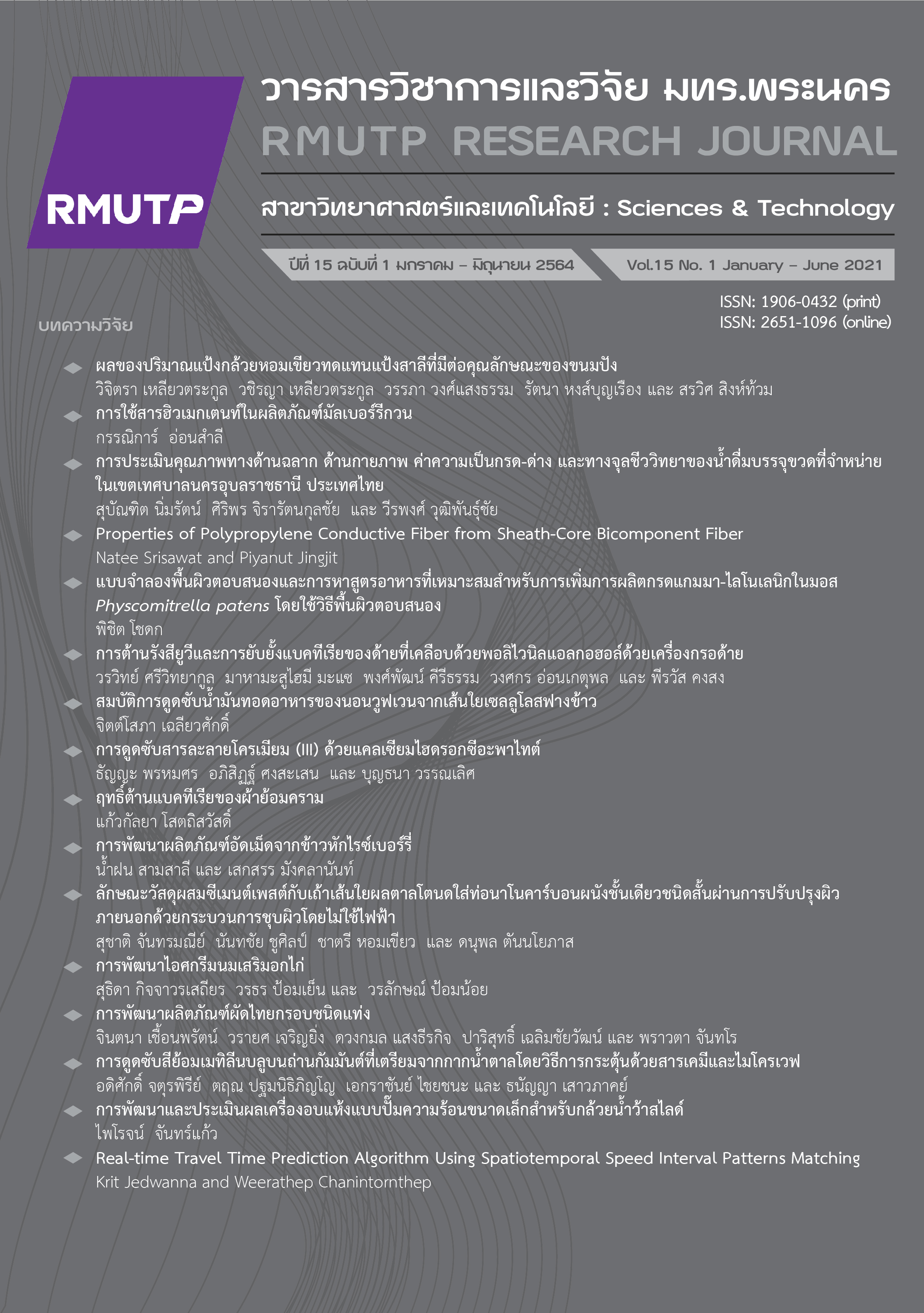Development of Pad Thai Crispy Bar
Main Article Content
Abstract
The aim of this research was to develop Pad Thai crispy bar, which is made from rice noodle (Chanthaburi's noodle), tofu, dried shrimp, garlic chives and peanut that have been cooked and dried. Mixed with Pad Thai sauce, then forming into a bar and dried. The study started with produced Pad Thai crispy bar made from three formula of Pad Thai sauce (A, B and C). Sensory evaluation by using 9-point hedonic scale showed that the highest liking score of appearance (7.36), taste (7.56) and overall liking (7.68) were obtained from formula A. Mixture design was used to optimize the formula of the Pad Thai crispy bar. The effect of three variables: tofu (70-90%) dried shrimp (10-15%) and garlic chives (13-25%) on the physical, chemical and sensory qualities of the product were investigated. The results showed that increasing the tofu decreased the lightness (L*) and hardness values of the product. Increasing the dried shrimp decreased the overall liking score. Optimum formula of tofu, dried shrimp and garlic chives was 72%, 13% and 15%, respectively. At this formula had the highest score of all sensory attributes were in the range of 6.86-7.24 (like slightly – like moderately). The developed Pad Thai crispy bar had the value of aw and hardness value 0.24 and 7.00 N, respectively. In addition, the developed product consisted of 9.17% moisture (wet weight basis), total carbohydrate, fat, ash and crude fiber which were 50.04%, 30.80%, 15.82%, 3.34% and 1.98% (dry weight basis), respectively. The energy value determined by Bomb calorimeter which were 582.10 Kcal per serving (10 pieces) and the cost of Pad Thai crispy bar was 21.60 bath per serving (80 g).
Article Details
References
W. Kaewsuwan, “The finished sauce for Pad Thai from tamarind paste juice,” Wichcha Journal Nakhon Si Thammarat Rajabhat University, vol. 32, no.1, pp. 55-62, Jan.-Jun. 2013.
P. Khowiboonchai, “Power negotiation and the changing meaning of Pad-Thai: from nationalist menu to popular Thai national dish,” journal of language and culture, vol. 32, no. 2, pp. 75-94, Jul.-Dec. 2013.
Travizgo. (2019, July 10). Top 10 Thai Food for Foreigners. [Online]. Available: https://blog.travizgo.com/education/10favoritefood/
Atlas Media Company. (2020, June 15). Most popular Thai noodle dishes. [Online]. Available: https://www.tasteatlas.com/most-popular-noodles-in-thailand
P. Kaysabutra, “The campaign for noodles consumtion and vacation in relation to the nation-building policy during field marshal P. Pibulsonggram’s regime (1992-1944),” Bu Academic Review, vol. 10, no. 1, pp.136-149, Jan.-Jun. 2011.
C. Rintawong, “Development of completely freezing Pad Thai,” M.S. thesis, Dept. Home Ec., Rajamangala Univ., Bangkok, Thailand, 2008.
C. Auppathak, “The Study of Instant Pad Thai Powder Processing,” in Proceeding of The First RMUTP International Conference, Rajamangala University of Technology Phra Nakhon, Bangkok, 2010.
Asia Food Beverage. (n.d.). World Current trend of Snackification. [Online]. Available: http://asiafoodbeverage.com/old/fbm-blog/world-current-trend-of-snackification/2/
Smart SME Chanel. (2019, April 1). 9 food and beverage trends that SMEs should know to the needs of consumers in 2019. [Online]. Available: https://www.smartsme.co.th/content/218719
D. Chayasiripan, K. Jangchard, A. Jangchard, S. Chariyachotiler and S. Kongcharoenkiat, “The effect of main ingredients on qualities of snack bar flavored mee-krob,” in Proceeding of 51th Kasetsart University Annual Conference, Kasetsart University, Thailand, 2013, pp. 392-399.
Anonymous. (2019, December 1). 6 Pad-Thai recipes east and delicious around the world. [Online]. Available: https://cooking.kapook.com/view132305.html
AOAC, Official Methods of Analysis of Association of Official Analytical Chemists, 18th ed. Washington DC: Gaithersburg, 2010.
N. Kunna, “Utilization of Sinlek Rice and Sorghum for Producing High Fiber Puffed Snack by Extrusion Process,” M.S. thesis, Dept. Home Ec., Kasetsart Univ., Bangkok, Thailand, 2019.
A. Greeley, “Finding Pad Thai,” Gastronomica, vol. 9, no. 1, pp. 78-82, Feb. 2009.
O. Baik and G. Mittal, “Kinetics of tofu color changes during deep-fat frying,” Lwt-Food Science and Technology, vol. 36, pp. 43-48, 2003.
S. Chanaram, K. Jangchud and A. Jangchud, “The effects if ingredients on qualities of snack bar from cereal and mixed fruit and vegetable,” in Proceeding of 46th Kasetsart University Annual Conference: Agro Industry, Kasetsart University, Thailand, 2008, pp. 579-587.
Thai Industry Standard Institute. (2016, sep. 29). Thai community product standard (Mee krop) 153/2559. [Online]. Available: http://tcps.tisi.go.th/pub/tcps0153_59.pdf
F. Sauvageot and G. Blond, “Effect of water activities on crispness of breakfast cereals,” Journal of Texture Studies, vol. 22, pp. 423-442, 1991.
S. Kijaworasatien, “Chapoo leaves added cereal bar product,” M.S. thesis, Dept. Home Ec., Rajamangala Univ. Bangkok, Thailand, 2010.
A. Ahmad, “Development of High Energy Cereal and Nut Granola Bar,” International Journal of Agriculture and Biological Sciences, vol. 1, pp. 13-20, Nov. 2017.
Dietary Reference Intake for Thais 2020, 4th ed., Ministry of Public Health, TH, 2020, pp. 39-130.


